You’ve likely experienced the frustration of a custom design project that didn’t capture your vision—despite countless emails and phone calls with your designer. The disconnect often stems from ineffective collaboration techniques that fail to bridge the gap between what you’re imagining and what’s actually being created. When done right, collaborative design transforms this process into something far more intuitive and satisfying, but most people don’t know where to start.
Understanding Client Vision and Design Goals
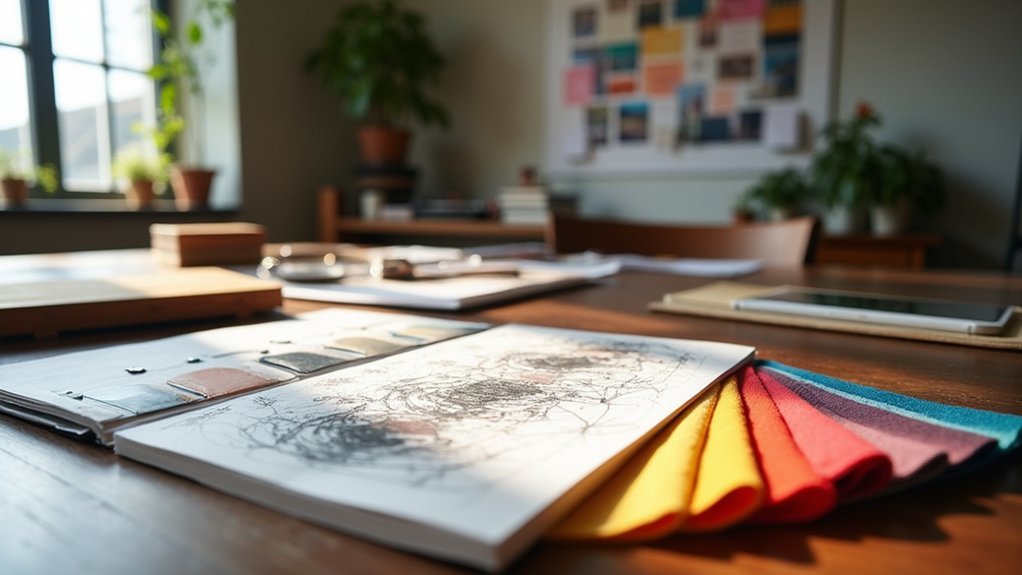
When commencing a collaborative design project, you’ll find that establishing clear communication forms the foundation of understanding your client’s vision and design goals.
You’ll need to create an environment where clients can articulate their preferences and expectations without hesitation. Reference images become invaluable tools during these discussions, providing tangible examples that bridge the gap between abstract ideas and concrete design elements.
Reference images transform vague client concepts into clear design direction, eliminating guesswork and creating shared understanding between designer and client.
During brainstorming sessions, encourage clients to be specific about modifications and design requests. This specificity reduces revisions and prevents project delays.
Active collaboration means engaging clients as partners in the creative process, balancing their insights with technical feasibility. Maintain continuous dialogue throughout the project, ensuring feedback is integrated effectively.
This approach transforms client input into actionable design decisions that align with their vision.
Establishing Effective Communication Channels
You’ll need multiple communication channels to keep your design team and clients connected throughout the project lifecycle.
Setting up dedicated pathways like email for formal updates, instant messaging for quick questions, and video calls for complex discussions guarantees everyone can reach each other when needed.
Real-time collaboration tools like Slack, Microsoft Teams, or project management platforms allow you to share files, track progress, and maintain ongoing conversations in one centralized location.
Multi-Channel Communication Setup
Since successful collaborative design depends on seamless information flow, you need to establish multiple communication channels that serve different purposes throughout your project lifecycle.
Start by implementing collaboration tools like Slack for instant messaging and Google Docs for real-time document sharing. This combination guarantees you’re capturing both quick decisions and detailed feedback effectively.
Schedule regular video conferences to maintain personal connections and provide visual context during design discussions. You’ll find that face-to-face interaction strengthens team relationships and reduces misunderstandings.
Create a structured feedback process using dedicated logs to systematically track client suggestions and team input.
Encourage open communication through organized brainstorming sessions where diverse perspectives can emerge naturally, keeping everyone aligned on project expectations and goals.
Real-Time Collaboration Tools
Real-time collaboration tools transform how your design team communicates and creates together, eliminating the bottlenecks that traditionally slow down custom jewelry projects.
Platforms like Slack and Figma enable seamless communication and design sharing, reducing delays while enhancing productivity throughout your creative process.
You’ll streamline feedback collection using centralized platforms like Filestage, which minimize project revisions by consolidating discussions in one collaborative environment.
Google Docs and Asana keep all stakeholders aligned through effective task management and document sharing during design and production phases.
Video conferencing provides visual aids that clarify design details and client expectations, fostering transparent collaboration.
Visual Reference Gathering and Mood Boards
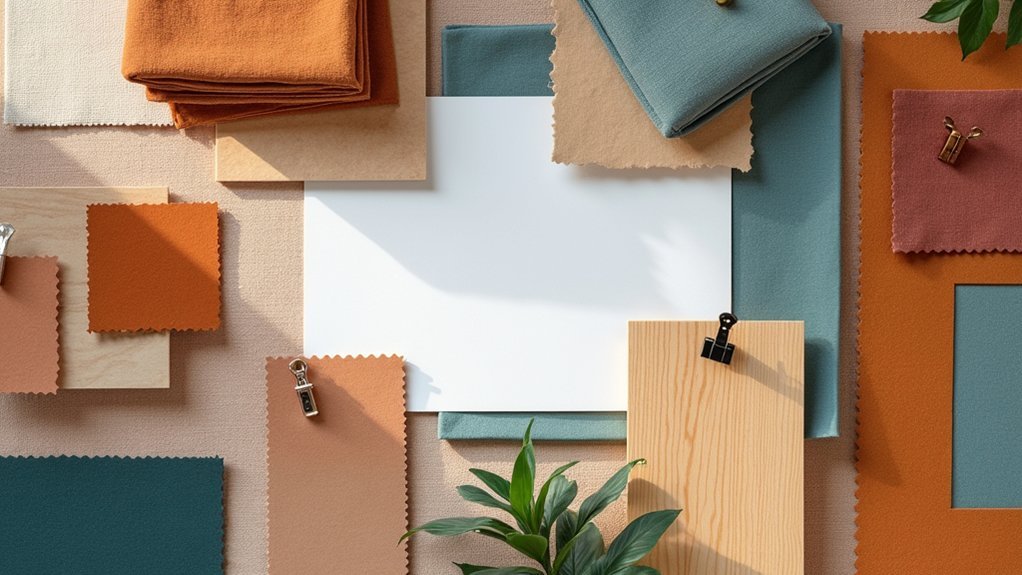
You’ll transform your collaborative design process by actively collecting visual inspirations alongside your team members, creating a shared foundation of ideas and aesthetic direction.
Building collaborative mood boards becomes your central hub for communicating concepts, textures, and color schemes that align everyone’s vision.
Your reference curation strategies will determine how effectively you can organize, update, and leverage these visual assets throughout the entire design journey.
Collecting Visual Inspirations Together
How do you transform abstract design concepts into tangible visions that everyone can understand and rally behind?
You’ll need to bring your team together to collect visual inspiration systematically. This collaborative approach guarantees everyone’s creative voice contributes to the final design direction.
When gathering visual inspiration with your team, you’ll create stronger mood boards that reflect diverse perspectives.
Using collaborative tools like Figma or Pinterest allows real-time contributions and edits, making the process more dynamic and inclusive.
Here’s how to collect visual inspirations effectively:
- Schedule dedicated brainstorming sessions where team members share images and references
- Create shared digital boards using platforms that support simultaneous editing
- Encourage diverse sources from architecture to nature photography
- Document reasoning behind each selection to maintain focus and clarity
Building Collaborative Mood Boards
Building collaborative mood boards transforms scattered inspirations into unified visual narratives that guide your entire design process.
You’ll gather diverse visual references from all stakeholders, ensuring everyone’s perspective shapes the creative process. Tools like Figma or Mural let team members contribute images, colors, and textures in real-time, creating an inclusive environment that welcomes a diverse range of ideas.
These visual communication tools align your team and clients on design concepts, reducing misunderstandings and streamlining feedback loops.
You’ll enhance innovation by incorporating stakeholder input during creation, combining different inspirations into cohesive visions.
Update your mood boards regularly throughout the collaborative design process to maintain alignment with project objectives and accommodate evolving creative insights that emerge from ongoing team collaboration.
Reference Curation Strategies
When curating visual references for custom jewelry design, you’re fundamentally building a visual vocabulary that speaks to both aesthetic preferences and emotional resonance.
Effective reference curation requires strategic approaches that maximize creative potential while guaranteeing clear communication between all stakeholders.
Your reference curation strategy should include:
- Diverse source gathering – Collect images, sketches, and materials from various inspirations to spark creative ideas.
- Digital collaboration software – Utilize platforms like Pinterest or Figma for seamless sharing and real-time collaboration.
- Client feedback integration – Actively incorporate client input throughout the curation process to guarantee personal resonance.
- Visual synthesis techniques – Create all-encompassing mood boards that align color palettes, textures, and styles into cohesive design directions.
This systematic approach transforms scattered inspirations into focused design visions that resonate with your client’s unique style preferences.
Sketching and Initial Concept Development

A pencil stroke on paper transforms abstract thoughts into tangible ideas that your entire team can see, discuss, and build upon together.
Sketching becomes the foundation of your collaborative effort, bridging communication gaps between designers, team members, and clients.
Whiteboard sketching encourages simultaneous contribution from multiple participants, creating an environment where creativity flows freely.
You’ll find that Crazy Eights exercises push your team to generate eight concepts in just five minutes, accelerating idea generation and uncovering unexpected solutions.
Incorporating client feedback during this initial phase guarantees your concepts align with their vision and preferences.
Through iterative sketching sessions, you’ll refine ideas continuously, exploring various design directions before committing to final development.
This approach enhances quality while maintaining collaborative momentum throughout your custom piece creation process.
Material Selection and Feasibility Assessment
Your material choices define both the aesthetic impact and structural integrity of your custom jewelry piece. Through careful material selection and feasibility assessment, you’ll navigate the balance between artistic vision and practical production requirements.
Effective communication with your clients guarantees you understand their preferences while explaining material limitations and possibilities. This collaborative approach prevents costly revisions and disappointments later in the process.
Key steps for successful material evaluation include:
- Analyze durability requirements based on intended use and wear patterns
- Utilize CAD renderings to visualize material interactions and potential issues
- Assess production capabilities against selected materials and design complexity
- Establish continuous dialogue with clients throughout the decision-making process
This systematic approach helps you identify structural challenges early while maintaining open communication channels that keep projects aligned with both creative goals and manufacturing realities.
Digital Design Tools for Collaborative Creation
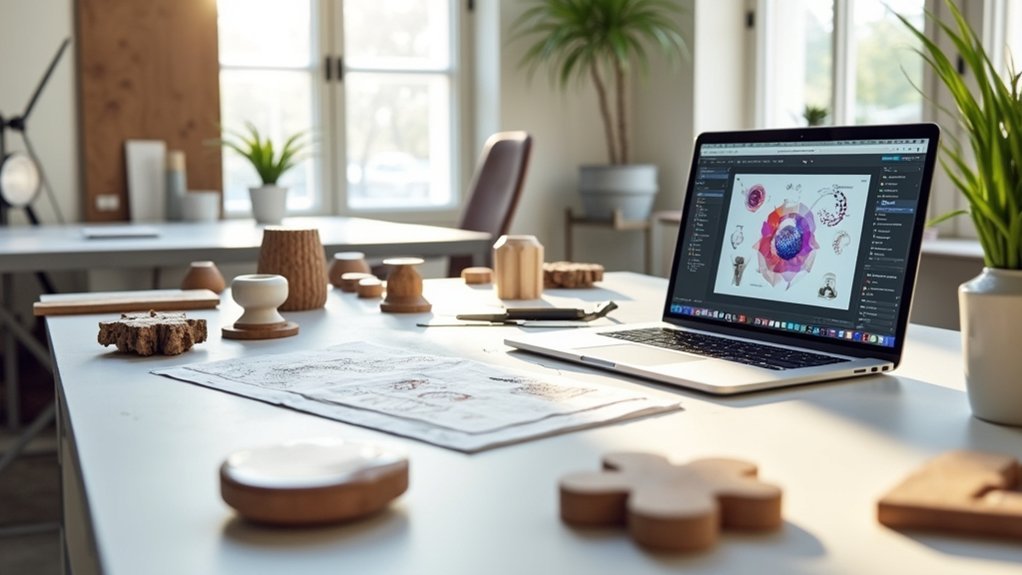
Building on your material selection foundation, digital design tools transform custom jewelry creation into a truly collaborative process where real-time interaction replaces traditional back-and-forth exchanges.
Figma enables simultaneous multi-user editing, letting your team develop concepts together while maintaining creative momentum. You’ll streamline your workflow using Filestage for centralized feedback collection, ensuring all stakeholder input shapes your final design.
Simultaneous multi-user editing maintains creative momentum while centralized feedback collection ensures every stakeholder voice shapes the final design outcome.
CAD software becomes your precision instrument for creating accurate renderings that integrate client revisions seamlessly. Slack keeps your designers, manufacturers, and clients aligned throughout production, eliminating costly miscommunications.
When you’re ready for ideation, brainstorming tools like FigJam let your team sketch and share visual concepts instantly. These collaborative design platforms don’t just improve efficiency—they reveal innovative solutions that traditional isolated design methods simply can’t achieve.
Prototype Development and Testing
Once your collaborative design concepts take shape through digital tools, prototype development becomes the vital bridge between imagination and reality in custom jewelry creation.
You’ll transform digital designs into tangible representations that stakeholders can examine, handle, and evaluate before committing to full production.
Testing prototypes enables you to gather essential user feedback and assess real-world usability. This collaborative design approach guarantees your concepts align with client expectations while identifying potential issues early in the process.
Your prototype development workflow should include:
- Initial concept validation through rapid prototyping methods
- Stakeholder feedback sessions to gather input from all team members
- Iterative refinements based on testing results and user responses
- Final approval processes before moving to production phases
This systematic approach considerably reduces design iterations and accelerates your time-to-market.
Client Feedback Integration Methods
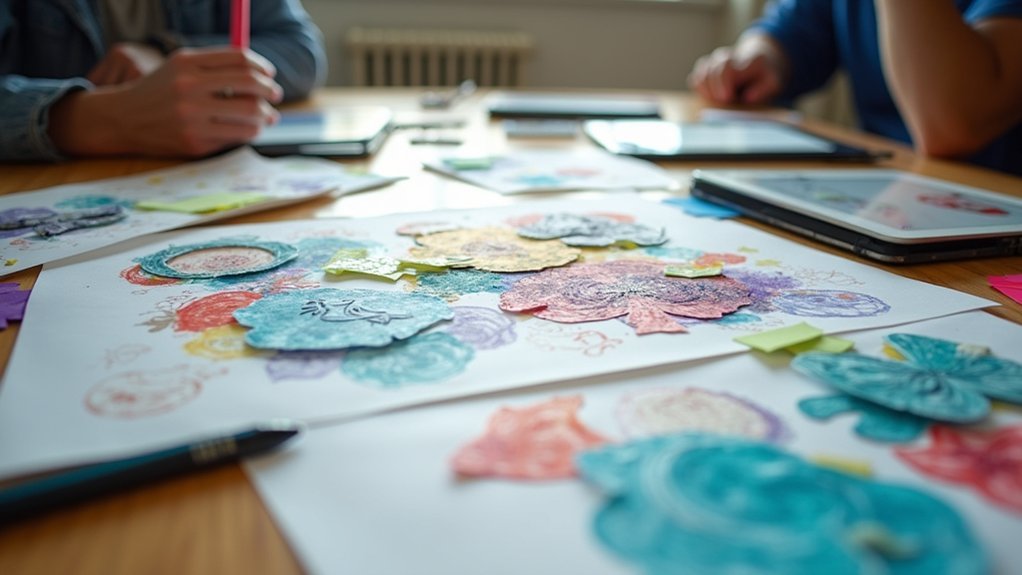
You’ll need efficient methods to capture and integrate client feedback throughout your collaborative design process.
Real-time input channels let you receive immediate responses, while iterative revision workflows guarantee you’re incorporating changes systematically at each design stage.
Structured approval systems create clear checkpoints where clients can formally review progress and authorize next steps, preventing scope creep and miscommunication.
Real-Time Input Channels
When you establish real-time input channels, you’re creating direct pathways for clients to share feedback instantly during the design process. These collaborative design tools transform traditional feedback cycles from days into minutes, allowing immediate course corrections that keep projects aligned with client expectations.
Real-time input channels streamline communication through several key approaches:
- Interactive design platforms like Figma and Mural enable clients to comment directly on specific design elements as you work.
- Centralized feedback systems such as Filestage organize all client comments in one trackable location.
- Live video sessions facilitate visual clarification of preferences and concerns through screen sharing.
- Instant messaging integration via Slack guarantees prompt collection and response to client feedback.
This immediate integration of client feedback reduces misunderstandings, accelerates project timelines, and considerably improves final outcomes while enhancing overall client satisfaction.
Iterative Revision Workflows
As you move beyond real-time feedback collection, implementing structured iterative revision workflows guarantees client input transforms into actionable design improvements through systematic cycles of review, refinement, and validation.
You’ll establish continuous feedback loops where client preferences guide each design evolution. Tools like Google Docs and Filestage centralize feedback collection, eliminating endless email chains and unnecessary meetings.
Document every client comment through detailed notes and audio recordings to maintain perfect alignment throughout revisions. Schedule regular video calls for real-time discussions that clarify uncertainties and accelerate decision-making.
This iterative approach creates a collaborative environment where clients feel genuinely involved in the design process. You’ll not only deliver higher-quality final products but also build stronger client relationships through systematic engagement that transforms their vision into reality.
Structured Approval Systems
Although traditional feedback methods often create bottlenecks and confusion, structured approval systems establish clear checkpoints where client input becomes seamlessly integrated into your design workflow.
These systems streamline communication by defining specific stages where your design team requires client feedback, ensuring timely project progression.
You’ll benefit from implementing these strategic approaches:
- Centralized feedback platforms like Filestage enable clients to comment directly on designs, minimizing miscommunication.
- Scheduled review sessions maintain consistent alignment between your design team and clients.
- Visual documentation tools including CAD renderings help clients provide precise, actionable feedback.
- Comprehensive meeting records through audio, email, and video documentation keep everyone aligned on project expectations.
This structured approach transforms the feedback process from reactive chaos into proactive collaboration, reducing revisions and delays.
Design Iteration and Refinement Process
Since successful collaborative design rarely emerges from a single attempt, the design iteration and refinement process becomes the backbone of creating exceptional outcomes.
You’ll create multiple design versions that continuously evolve through systematic feedback loops from clients and stakeholders. Each iteration brings you closer to meeting both aesthetic and functional requirements.
Prototyping serves as your testing ground, allowing you to visualize concepts and identify potential issues before finalizing designs.
Prototyping transforms abstract ideas into tangible solutions, revealing hidden flaws and opportunities before committing to final design decisions.
You’ll work within cross-functional teams where diverse perspectives enhance each version’s quality. This collaborative design approach guarantees every team member’s expertise contributes to the refinement process.
Your goal isn’t perfection on the first try—it’s about methodical improvement.
Through design iteration, you’ll achieve solutions that resonate with clients while maintaining production feasibility and meeting project specifications.
Technical Specifications and Manufacturing Considerations
You’ll need to establish clear material selection protocols that align with your design vision while meeting manufacturing constraints.
Your production workflow integration must account for technical limitations and quality control measures from the earliest design phases.
This approach guarantees you’re creating specifications that manufacturers can execute consistently while maintaining your intended aesthetic and structural integrity.
Material Selection Protocols
When you’re selecting materials for custom jewelry, you’ll need to balance technical performance with aesthetic appeal and manufacturing feasibility. Your material selection protocol should integrate collaborative design principles while addressing durability requirements for daily wear pieces.
Essential Material Selection Criteria:
- Durability Assessment – Evaluate hardness ratings and resistance to scratching, tarnishing, or corrosion based on intended use.
- Manufacturing Compatibility – Consider melting points and workability for casting, soldering, or engraving techniques.
- Sustainable Sourcing – Verify ethical practices and traceability to meet modern consumer expectations.
- Client Collaboration – Incorporate personal significance and emotional connections to specific materials during selection discussions.
You’ll find that effective client collaboration during this process guarantees the final piece reflects both technical excellence and meaningful value.
This creates jewelry that performs beautifully while honoring the wearer’s personal story.
Production Workflow Integration
After finalizing your material selections, integrating these choices into a streamlined production workflow becomes critical for delivering exceptional custom jewelry. Your collaborative design approach must incorporate thorough client discussions to capture specifications accurately. CAD renderings enable visualization before production, facilitating team adjustments based on feedback.
| Phase | Key Activity | Quality Check |
|---|---|---|
| Design | Client consultation & CAD rendering | Feasibility analysis |
| Pre-production | Technical review & revisions | Structural assessment |
| Manufacturing | Fabrication execution | Process monitoring |
| Quality Control | Final inspection & audit | Standards verification |
Your production process requires continuous communication with iterative revisions ensuring alignment with client vision. Feasibility analysis addresses structural issues early, while strict auditing maintains consistent quality across pieces. This integrated workflow transforms collaborative design concepts into exceptional finished products.
Quality Assurance and Design Validation
Although collaborative design brings multiple perspectives together, maintaining quality standards requires deliberate validation processes that catch issues before they become costly problems.
Quality assurance in collaborative design demands systematic checks at every stage, ensuring your final product meets both client expectations and functionality requirements. Design validation confirms your creation aligns with user needs through thorough testing and feedback loops.
Systematic validation at every design stage ensures your final product meets client expectations and functional requirements through continuous testing.
Effective quality control involves these essential steps:
- Early visualization – Use CAD renderings to gather client feedback before production
- Iterative testing – Conduct regular user testing sessions throughout development
- Structured reviews – Implement formal approval processes for each design iteration
- Team communication – Maintain consistent feedback loops among all stakeholders
You’ll minimize costly revisions and enhance product quality by establishing these validation checkpoints throughout your collaborative design process.
Project Timeline Management and Milestones
Quality validation processes work hand-in-hand with structured timeline management to keep your collaborative design projects on track.
You’ll need clear project timeline management with defined milestones like initial sketches, CAD renderings, and prototype approvals. These checkpoints let you assess progress and make adjustments throughout your collaboration.
Use project management tools like Asana or Monday to organize tasks and maintain timeline visibility. This guarantees your entire team stays aligned on deadlines and responsibilities.
Regular communication updates through daily standups or weekly check-ins maintain momentum and address potential delays efficiently.
Set realistic deadlines for each design phase, including client feedback periods. This approach manages expectations while guaranteeing high-quality outcomes in your custom jewelry production process.
Documentation and Design Approval Workflows
When proper documentation forms the backbone of your design approval process, you’ll eliminate costly miscommunications and streamline client collaboration.
Clear project guidelines and requirements create mutual understanding between you and your clients, establishing expectations from the start.
Well-defined project parameters eliminate ambiguity and foster collaborative partnerships built on shared vision and realistic expectations.
Effective documentation and design approval workflows require these essential components:
- Reference materials – Compile visual examples and written descriptions that capture desired styles and effects
- Structured feedback sessions – Schedule regular check-ins with clients to gather input and make timely adjustments
- Visual meeting aids – Use recordings and presentations to clarify unclear details during discussions
- Iterative revision processes – Implement systematic approval stages that maintain quality while meeting project timelines
This approach transforms communication into a strategic advantage, ensuring your final designs consistently exceed client satisfaction.
Long-term Relationship Building Strategies
Strong documentation practices lay the groundwork for something even more valuable: lasting partnerships that generate consistent revenue and referrals.
You’ll strengthen long-term relationships by establishing mutual understanding early in each collaborative design project. This foundation builds trust that extends beyond individual pieces.
Maintain regular communication through structured meetings and feedback sessions. These touchpoints keep client expectations aligned with your capabilities while reducing costly revisions.
Reference images and written requirements clarify their vision, making your job easier. Transparency throughout customization makes clients feel valued and involved.
Create a feedback loop that incorporates their input at multiple production stages. This continuous improvement approach demonstrates your commitment to their satisfaction, encouraging repeat business and strengthening partnerships over time.
Frequently Asked Questions
What Is a Collaborative Approach to Designing?
You’ll actively engage multiple stakeholders throughout the design process, ensuring diverse perspectives shape the final product. You’ll use open communication, regular feedback loops, and shared ownership to create innovative, tailored solutions.
What Is an Example of Collaborative Design?
You’ll participate in initial brainstorming sessions with designers, sharing ideas and inspirations together. This creates mutual understanding of your desired piece, ensuring the final custom jewelry design reflects both your vision and professional expertise.
What Are the 7 Steps in the Design Process?
You’ll start by building a brief, then brainstorm ideas, select your best concept, develop sketches, gather stakeholder feedback, implement revisions, and finally validate against requirements before delivery.
What Are the Principles of Collaborative Design?
You’ll find collaborative design centers on five key principles: co-creation with all stakeholders, open communication throughout the process, continuous iteration through feedback, customer-centricity prioritizing user needs, and inclusion fostering shared ownership among participants.
In Summary
You’ll find that mastering collaborative design techniques transforms your custom piece projects from simple transactions into meaningful partnerships. By implementing structured communication channels, visual tools, and iterative processes, you’re not just creating products—you’re building lasting relationships with clients. Remember that each project you complete using these methods strengthens your reputation and sets the foundation for future collaborations. Your commitment to collaborative excellence will distinguish you in the custom design market.

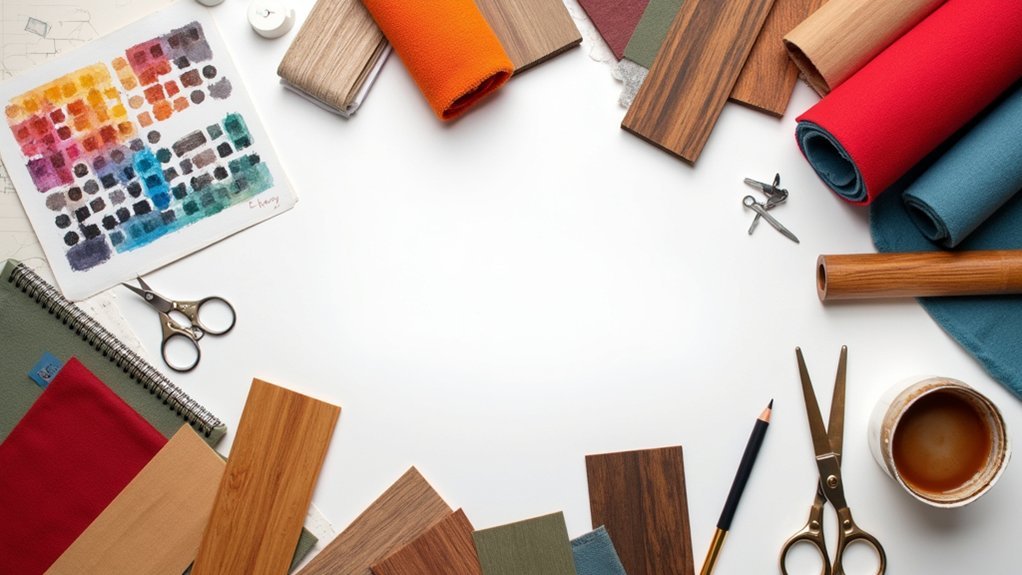



Leave a Reply